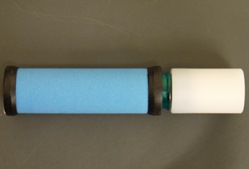The AMoN is the only network providing a consistent, long-term record of ammonia gas concentrations across the United States.
Ammonia (NH3) is a gas readily released into the air from a variety of biological sources, as well as from industrial and combustion processes. It is the most prevalent base gas in the atmosphere. While NH3 has many beneficial uses, it can detrimentally affect the quality of the environment through acidification and eutrophication of natural ecosystems, the associated loss of biodiversity, and the formation of secondary particles in the atmosphere, which can reduce visibility. Possible health effects of ammonia gas in the atmosphere include short-term irritation of the eyes and lungs and long-term effects on the cardiovascular system through inhalation of fine particulate matter formed from ammonia in the atmosphere.
The AMoN is the only national monitoring network in the U.S. that measures ambient ammonia gas (NH3). The objective of AMoN is to measure NH3 concentrations in a spatially dense, cost-efficient network with data of defined high quality. The AMoN began as a special study in the fall of 2007. The AMoN was approved as an official NADP network in October 2010. The network currently consists of approximately 92 sites, and additional sites are encouraged to join. More information about AMoN is available on this fact sheet.
Like the other NADP networks, AMoN would ideally operate for several decades in a large, spatially diverse network. This will provide data to evaluate long-term trends in ambient NH3 concentrations and deposition. Currently, there are no national-scale measurements to establish a baseline for measured NH3 concentrations. Once baseline concentrations are established using measurements from the AMoN, any changes in ambient NH3 concentrations due to emission reduction regulations can be assessed.
The AMoN provides land managers, air quality modellers, ecologists, and policymakers with critical data that will allow them to:
- assess the long-term trends in ambient NH3 concentrations and deposition of reduced nitrogen species;
- validate atmospheric models;
- better estimate total nitrogen inputs to ecosystems;
- assess changes in atmospheric chemistry due to SO2 and NOx reductions;
- assess compliance with PM2.5 standards; and
- evaluate possible long-term climate effects due to the spatial and temporal trends of ammonia gas in the atmosphere.
Information on joining the network is available here.
Data Notices
Metadata
Field Methods
The Radiello Diffusive Sampler
 The Radiello-brand sampler, a passive device for measuring atmospheric ammonia (or other gases), is a simple diffusion-type sampler with no moving parts. It works on diffusion theory, where ammonia is sorbed on the interior surface. This induces a concentration gradient from the outside of the sampler to the inside of the sampler.
The Radiello-brand sampler, a passive device for measuring atmospheric ammonia (or other gases), is a simple diffusion-type sampler with no moving parts. It works on diffusion theory, where ammonia is sorbed on the interior surface. This induces a concentration gradient from the outside of the sampler to the inside of the sampler.
Phosphoric acid is impregnated on the interior cartridge. This cartridge is placed inside the porous outer body, which provides a predictable diffusion distance and a reproducible diffusion rate of ammonia gas to the interior sorbent. For analysis, the sampler is returned to the laboratory, where the cartridges are removed, and the ammonia (as NH4+) is removed by sonication in deionized water.
Laboratory analysis for ammonium is accomplished by Flow Injection Analysis (FIA).

The sampler shelter consists of an inverted plastic shelter permanently fastened to an aluminum u-channel mounting bracket (see diagram). The shelter is erected such that the lower edge is 2 meters (80 inches) above surrounding surfaces. Triplicate ammonia samples are mounted within the shelter.
Samplers are not mounted near plumbing stacks, chimneys, vents, exhausts or other possible sources of direct ammonia emissions.
The vertical arm of the aluminum bracket can be fastened to a metal fence post. Alternatively, the shelter can be mounted on a suitable wooden post or pole by using screws (or small lag bolts) driven through the predrilled holes in the lower part of the bracket.
Lab Methods
The current listing of laboratory SOPs are available. Copies are available upon request.
